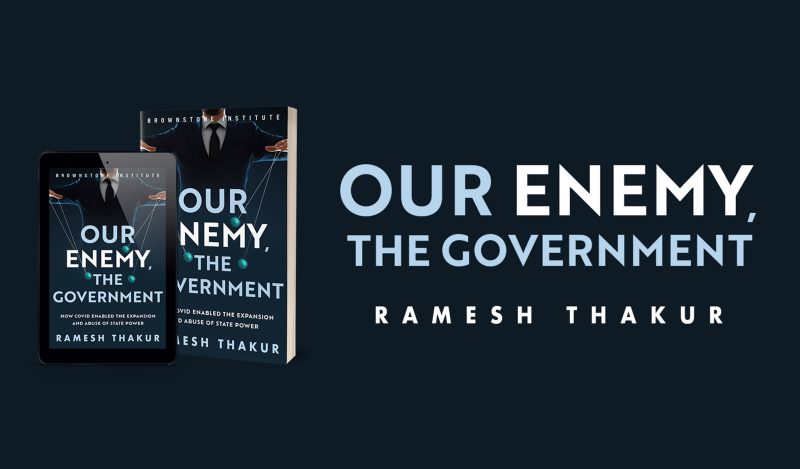A federal appeals court in New Orleans has stopped the vaccination and testing requirement for private businesses as ordered by the Biden administration and the Labor Department’s regulatory division for workplace safety. The decision is notable not only for its decisive judgement but also for its striking language that properly frames the draconian edict for what it is, and decries in pointed language the goal and methods being deployed against workers.
Below are excerpts from the decision in BST Holdings, L.L.C. vs OSHA, November 12, 2021:
- We begin by stating the obvious. The Occupational Safety and Health Act, which created OSHA, was enacted by Congress to assure Americans “safe and healthful working conditions and to preserve our human resources.” See 29 U.S.C. § 651 (statement of findings and declaration of purpose and policy). It was not—and likely could not be, under the Commerce Clause and nondelegation doctrine8—intended to authorize a workplace safety administration in the deep recesses of the federal bureaucracy to make sweeping pronouncements on matters of public health affecting every member of society in the profoundest of ways.
- On the dubious assumption that the Mandate does pass constitutional muster—which we need not decide today—it is nonetheless fatally flawed on its own terms. Indeed, the Mandate’s strained prescriptions combine to make it the rare government pronouncement that is both overinclusive (applying to employers and employees in virtually all industries and workplaces in America, with little attempt to account for the obvious differences between the risks facing, say, a security guard on a lonely night shift, and a meatpacker working shoulder to shoulder in a cramped warehouse) and underinclusive (purporting to save employees with 99 or more coworkers from a “grave danger” in the workplace, while making no attempt to shield employees with 98 or fewer coworkers from the very same threat). The Mandate’s stated impetus—a purported “emergency” that the entire globe has now endured for nearly two years,10 and which OSHA itself spent nearly two months responding to11—is unavailing as well. And its promulgation grossly exceeds OSHA’s statutory authority.
- After the President voiced his displeasure with the country’s vaccination rate in September,12 the Administration pored over the U.S. Code in search of authority, or a “work-around,”13 for imposing a national vaccine mandate. The vehicle it landed on was an OSHA ETS. The statute empowering OSHA allows OSHA to bypass typical notice-and-comment proceedings for six months by providing “for an emergency temporary standard to take immediate effect upon publication in the Federal Register” if it “determines (A) that employees are exposed to grave danger from exposure to substances or agents determined to be toxic or physically harmful or from new hazards, and (B) that such emergency standard is necessary to protect employees from such danger.”
… - Here, OSHA’s attempt to shoehorn an airborne virus that is both widely present in society (and thus not particular to any workplace) and non-life- threatening to a vast majority of employees into a neighboring phrase connoting toxicity and poisonousness is yet another transparent stretch.
… - Equally problematic, however, is that it remains unclear that COVID-19—however tragic and devastating the pandemic has been—poses the kind of grave danger § 655(c)(1) contemplates. See, e.g., Int’l Chem. Workers, 830 F.2d at 371 (noting that OSHA itself once concluded “that to be a ‘grave danger,’ it is not sufficient that a chemical, such as cadmium, can cause cancer or kidney damage at a high level of exposure” (emphasis added)). For starters, the Mandate itself concedes that the effects of COVID-19 may range from “mild” to “critical.” As important, however, the status of the spread of the virus has varied since the President announced the general parameters of the Mandate in September. (And of course, this all assumes that COVID-19 poses any significant danger to workers to begin with; for the more than seventy-eight percent16 of Americans aged 12 and older either fully or partially inoculated against it, the virus poses—the Administration assures us—little risk at all.) See, e.g., 86 Fed. Reg. 61,402, 61,402–03 (“COVID-19 vaccines authorized or approved by the [FDA] effectively protect vaccinated individuals against severe illness and death from COVID-19.”).
… - We next consider the necessity of the Mandate. The Mandate is staggeringly overbroad. Applying to 2 out of 3 private-sector employees in America, in workplaces as diverse as the country itself, the Mandate fails to consider what is perhaps the most salient fact of all: the ongoing threat of COVID-19 is more dangerous to some employees than to other employees. All else equal, a 28 year-old trucker spending the bulk of his workday in the solitude of his cab is simply less vulnerable to COVID-19 than a 62 year-old prison janitor. Likewise, a naturally immune unvaccinated worker is presumably at less risk than an unvaccinated worker who has never had the virus. The list goes on, but one constant remains—the Mandate fails almost completely to address, or even respond to, much of this reality and common sense.
- Moreover, earlier in the pandemic, the Agency recognized the practical impossibility of tailoring an effective ETS in response to COVID-19.
… - At the same time, the Mandate is also underinclusive. The most vulnerable worker in America draws no protection from the Mandate if his company employs 99 workers or fewer. The reason why? Because, as even OSHA admits, companies of 100 or more employers will be better able to administer (and sustain) the Mandate. See 86 Fed. Reg. 61,402, 61,403 (“OSHA seeks information about the ability of employers with fewer than 100 employees to implement COVID-19 vaccination and/or testing programs.”). That may be true. But this kind of thinking belies the premise that any of this is truly an emergency. Indeed, underinclusiveness of this sort is often regarded as a telltale sign that the government’s interest in enacting a liberty-restraining pronouncement is not in fact “compelling.” Cf. Church of the Lukumi Babalu Aye, Inc. v. City of Hialeah, 508 U.S. 520, 542–46 (1993) (city’s ban on religious animal sacrifice but corresponding allowance of other activities similarly endangering public health belied its purportedly “compelling” interest in safe animal disposal practices). The underinclusive nature of the Mandate implies that the Mandate’s true purpose is not to enhance workplace safety, but instead to ramp up vaccine uptake by any means necessary.
… - It lastly bears noting that the Mandate raises serious constitutional concerns that either make it more likely that the petitioners will succeed on the merits, or at least counsel against adopting OSHA’s broad reading of § 655(c) as a matter of statutory interpretation.
- First, the Mandate likely exceeds the federal government’s authority under the Commerce Clause because it regulates noneconomic inactivity that falls squarely within the States’ police power. A person’s choice to remain unvaccinated and forgo regular testing is noneconomic inactivity. Cf. NFIB v. Sebelius, 567 U.S. 519, 522 (2012) (Roberts, C.J., concurring); see also id. at 652–53 (Scalia, J., dissenting). And to mandate that a person receive a vaccine or undergo testing falls squarely within the States’ police power.
- The Mandate, however, commandeers U.S. employers to compel millions of employees to receive a COVID-19 vaccine or bear the burden of weekly testing. 86 Fed. Reg. 61,402, 61,407, 61,437, 61,552. The Commerce Clause power may be expansive, but it does not grant Congress the power to regulate noneconomic inactivity traditionally within the States’ police power. … In sum, the Mandate would far exceed current constitutional authority.
- Second, concerns over separation of powers principles cast doubt over the Mandate’s assertion of virtually unlimited power to control individual conduct under the guise of a workplace regulation. As Judge Duncan points out, the major questions doctrine confirms that the Mandate exceeds the bounds of OSHA’s statutory authority. Congress must “speak clearly if it wishes to assign to an agency decisions of vast economic and political significance.” Util. Air Regul. Grp. v. EPA, 573 U.S. 302, 324 (2014) (cleaned up). The Mandate derives its authority from an old statute employed in a novel manner, imposes nearly $3 billion in compliance costs, involves broad medical considerations that lie outside of OSHA’s core competencies, and purports to definitively resolve one of today’s most hotly debated political issues. Cf. MCI Telecomms. Corp. v. AT&T, 512 U.S. 218, 231 (1994) (declining to hold that the FCC could eliminate telecommunications rate-filing requirements); FDA v. Brown & Williamson Tobacco Corp., 529 U.S. 120, 159–60 (2000) (declining to hold that the FDA could regulate cigarettes); Gonzales v. Oregon, 546 U.S. 243, 262 (2006) (declining to allow DOJ to ban physician-assisted suicide). There is no clear expression of congressional intent in § 655(c) to convey OSHA such broad authority, and this court will not infer one. Nor can the Article II executive breathe new power into OSHA’s authority—no matter how thin patience wears.
- It is clear that a denial of the petitioners’ proposed stay would do them irreparable harm. For one, the Mandate threatens to substantially burden the liberty interests of reluctant individual recipients put to a choice between their job(s) and their jab(s). For the individual petitioners, the loss of constitutional freedoms “for even minimal periods of time . . . unquestionably constitutes irreparable injury.” Elrod v. Burns, 427 U.S. 347, 373 (1976) (“The loss of First Amendment freedoms, for even minimal periods of time, unquestionably constitutes irreparable injury.”).
… - For similar reasons, a stay is firmly in the public interest. From economic uncertainty to workplace strife, the mere specter of the Mandate has contributed to untold economic upheaval in recent months. Of course, the principles at stake when it comes to the Mandate are not reducible to dollars and cents. The public interest is also served by maintaining our constitutional structure and maintaining the liberty of individuals to make intensely personal decisions according to their own convictions—even, or perhaps particularly, when those decisions frustrate government officials.
… - In addition, IT IS FURTHER ORDERED that OSHA take no steps to implement or enforce the Mandate until further court order.
Published under a Creative Commons Attribution 4.0 International License
For reprints, please set the canonical link back to the original Brownstone Institute Article and Author.









